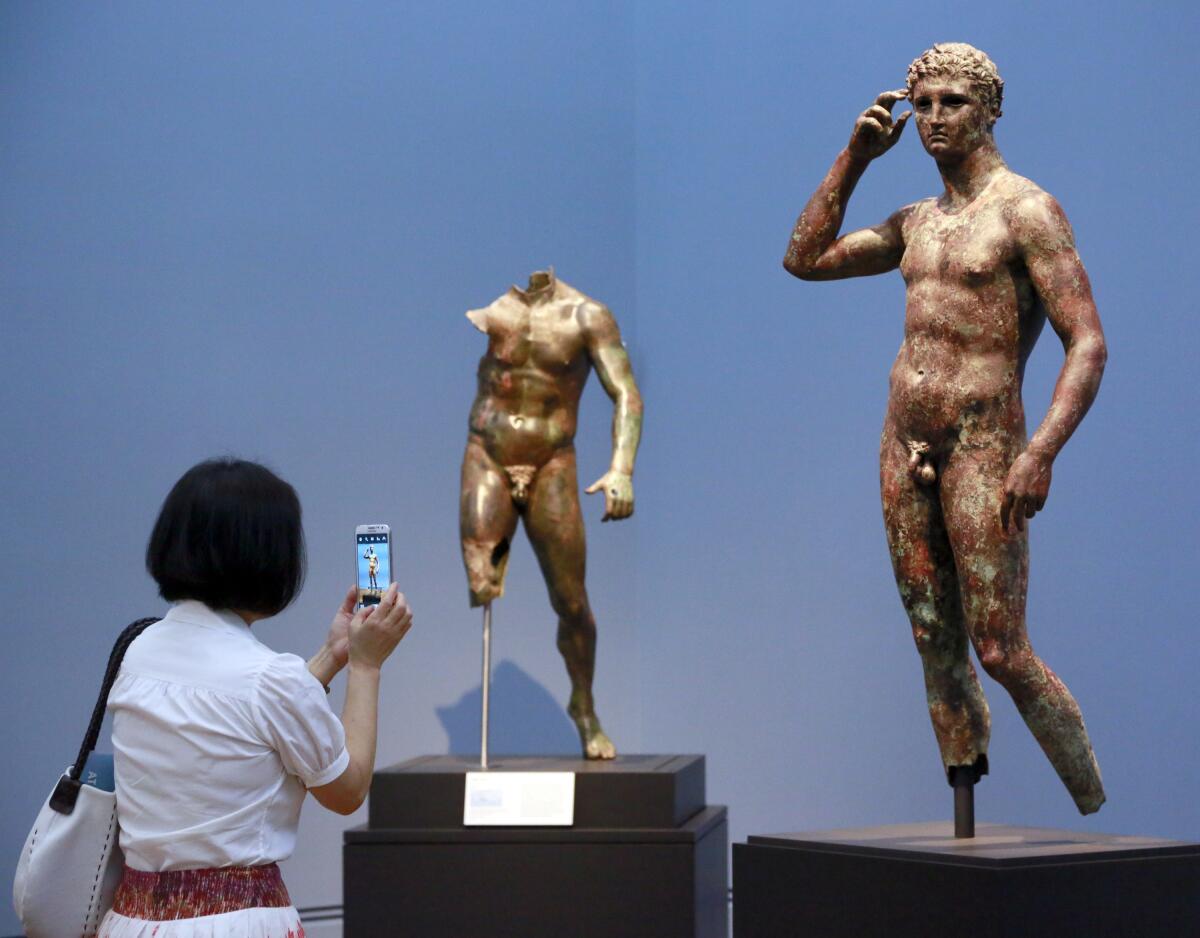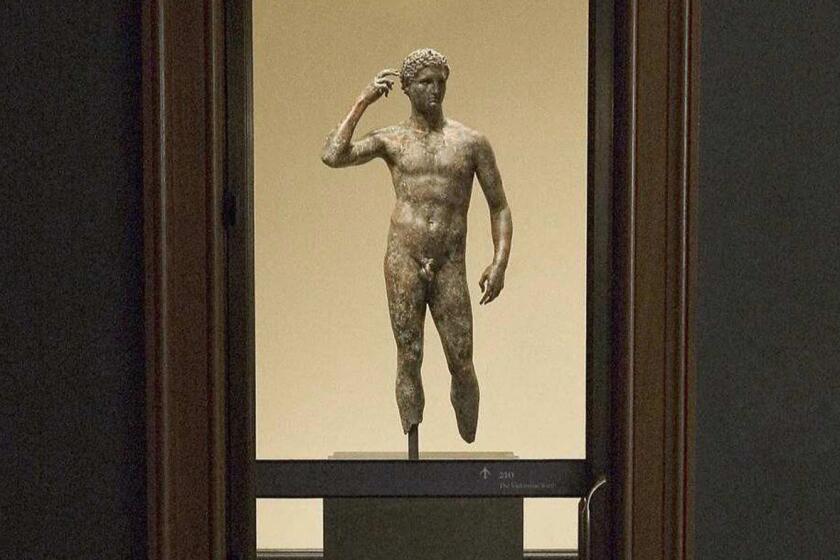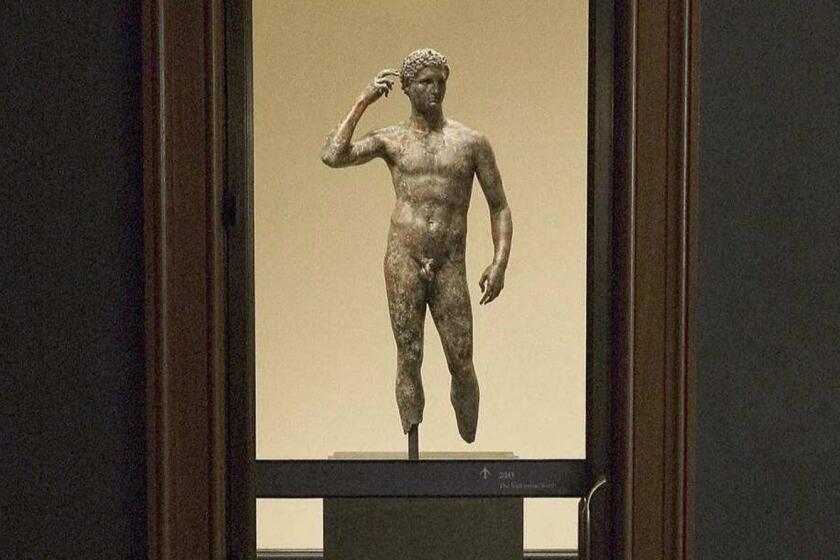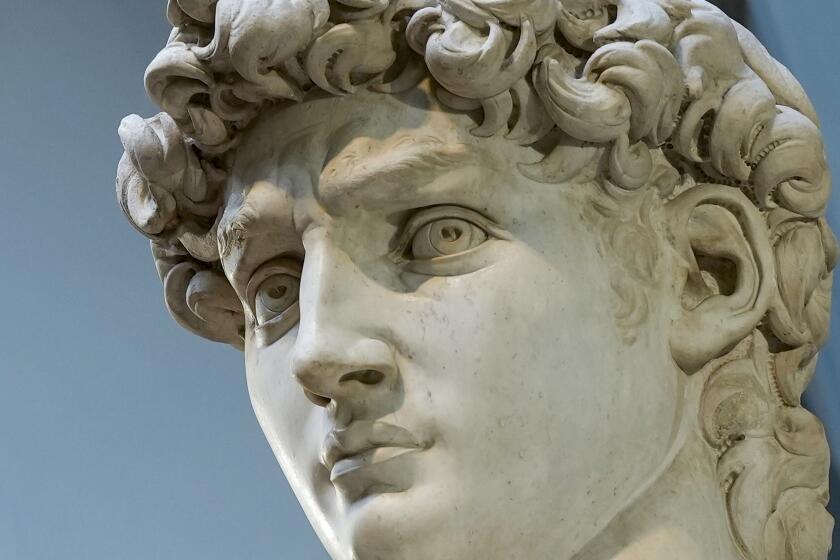European court upholds Italy’s right to seize prized Greek bronze from Getty Museum

ROME ‚ÄĒ A European court on Thursday upheld Italy‚Äôs right to seize a prized Greek statue from the J. Paul Getty Museum in Los Angeles, ruling that Italy was justified in trying to reclaim an important part of its cultural heritage and rejecting the museum‚Äôs appeal.
The European Court of Human Rights, or ECHR, determined that Italy‚Äôs decades-long efforts to recover the ‚ÄúVictorious Youth‚ÄĚ statue from the Getty were not disproportionate.
‚ÄúVictorious Youth,‚ÄĚ a life-sized bronze dating from 300 to 100 B.C., is one of the highlights of the Getty collection. Though the artist is unknown, some scholars believe it was made by Lysippos, Alexander the Great‚Äôs personal sculptor.
The so-called Getty Bronze, which was pulled from the sea in 1964 by Italian fishermen and then exported out of Italy illegally, was purchased by the Getty in 1977 for $4 million and has been on display there ever since.
Italy’s version of the Supreme Court has ruled that one of the J.
The Getty had appealed to the European court after Italy’s Supreme Court of Cassation in 2018 upheld a lower court’s confiscation order. The Italian legal rulings were part of the country’s years-long campaign to recover antiquities looted from its territory and sold to museums and private collectors around the globe.
The Getty had argued that its rights to the statue, under a European human rights protocol on protection of property, had been violated by Italy’s campaign to get it back.
The European court ruled Thursday that no such violation had occurred. And it went even further, affirming what Italy’s high court had determined: that the statue was part of Italy’s cultural heritage, that international law strongly supported Italy’s efforts to recover it, and that the Getty had been at best negligent when it bought it without properly ascertaining its provenance.
‚ÄúThis is not just a victory for the Italian government. It‚Äôs a victory for culture,‚ÄĚ said Maurizio Fiorilli, who as an Italian government attorney had spearheaded Italy‚Äôs efforts to recover its looted antiquities and, in particular, the Getty Bronze.
The Getty has long defended its right to the statue, saying Italy had no legal claim to it. The museum vowed Thursday to continue the legal battle to keep it.
Despite Thursday‚Äôs ruling, ‚Äúwe believe that Getty‚Äôs nearly 50-year public possession of an artwork that was neither created by an Italian artist nor found within the Italian territory is appropriate, ethical and consistent with American and international law,‚ÄĚ the museum said in a statement.
Among other things, the Getty has argued that the statue is of Greek origin, was found in international waters and was never part of Italy’s cultural heritage. It has cited a 1968 Court of Cassation ruling that found no evidence that the statue belonged to Italy.
Italy argued, and the Court of Cassation later found, that the statue was indeed part of its own cultural heritage, that it was brought to shore by Italians aboard an Italian-flagged ship and was exported illegally.
Thursday’s decision by the Strasbourg, France-based ECHR was a chamber judgment. Both sides now have three months to ask that the case be heard by the court’s Grand Chamber for a final decision.
Italian Culture Minister Gennaro Sangiuliano praised Thursday‚Äôs decision as an ‚Äúunequivocal ruling‚ÄĚ that recognized the rights of the Italian state and its ownership of the statue.
The statue is towering figure in Italian culture. The state‚Äôs attorney office in Florence pursues legal action against vendors ‚Äėdebasing‚Äô it.
‚ÄúFollowing today‚Äôs ruling ‚Ķ the Italian government will restart contacts with U.S. authorities for assistance in the implementation of the confiscation order,‚ÄĚ he said.
ECHR rulings are binding on the states that are party to the court.
The U.S. is not a party but it has a tradition of judicial cooperation with Italy. Italy had asked the U.S. attorney general‚Äôs office to enforce the confiscation order in 2019. The ECHR ruling noted that the ‚Äúprocedure is still pending.‚ÄĚ
Sanguiliano reiterated Italy’s campaign to bring its looted treasures home and noted that recently Italy has ceased cooperation with foreign museums that don’t recognize Italian confiscation orders.
Recently, Italy banned any loans to the Minneapolis Institute of Art following a dispute over an ancient marble statue believed to have been looted from Italy almost a half-century ago.
The Getty had appealed to the ECHR by arguing, among other things, that Italy’s 2010 confiscation order constituted a violation of its right to enjoy its possessions and that it would be deprived of that right if U.S. authorities carried out the seizure.
The ECHR, however, strongly reaffirmed Italy’s right to pursue the protection of its cultural heritage.
A Jewish family’s quest to reclaim a masterpiece painting stolen by the Nazis takes them across oceans and continents, into courts and back through time.
‚ÄúThe court further held that owing, in particular, to the Getty Trust‚Äôs negligence or bad faith in purchasing the statue despite being aware of the claims of the Italian state and their efforts to recover it, the confiscation order had been proportionate to the aim of ensuring the return of an object that was part of Italy‚Äôs cultural heritage,‚ÄĚ said the summary of the ruling.
The Getty Bronze is a signature piece for the museum. Standing about 5 feet tall, the representation of a young athlete raising his right hand to an olive wreath crown around his head is one of the few life-sized Greek bronzes to have survived.
The bronze is believed to have sunk with the ship that was carrying it to Italy after the Romans conquered Greece. After being found in the nets of Italian fishermen trawling in international waters in 1964, it was allegedly buried in an Italian cabbage patch and hidden in a priest’s bathtub before it was taken out of the country.
The statue resurfaced in Germany in the early 1970s in the possession of a German art dealer, identified in court documents as Mr. H.H., who was holding it on behalf of a Liechtenstein-based company.
In 1972, advisors to J. Paul Getty, the American oil magnate and art collector, entered into negotiations with Mr. H.H. to purchase it.
The ECHR ruling reproduced court documentation showing Getty himself wanted to be assured that he could obtain legal title to the statue.
But the ECHR ruling said Getty‚Äôs advisors didn‚Äôt go far enough in ascertaining whether the sellers had acquired it and exported it legally from Italy. It said they relied on legal opinions from the sellers‚Äô lawyers who ‚Äúhad a clear interest in presenting the provenance as legitimate.‚ÄĚ
Thousands of precious antiquities disappeared from Cambodia during decades of war and strife. Now the country is taking on California museums to get them back.
Citing the lower court rulings, the ECHR judges determined the Getty Trust had ‚Äúvery weighty reason to doubt the statue‚Äôs legitimate provenance.‚ÄĚ When Getty officials went ahead and purchased it anyway, they acted ‚Äúat the very least, negligent, if not in bad faith.‚ÄĚ
It said the Getty couldn‚Äôt expect to be compensated for the statue, since it ‚Äúaccepted, at least implicitly, the risk that the statue might be confiscated.‚ÄĚ
Italy has successfully won back thousands of artifacts from museums, collections and private owners around the world that it says were looted or stolen from the country illegally. It recently opened a museum to house them until they can be returned to the regions from where they were taken.
The most important work to date that Italy has brought back is the Euphronios Krater, one of the finest ancient Greek vases in existence. The Metropolitan Museum of Art in New York, which purchased it for $1 million in 1972 from an art dealer later accused of acquiring looted artifacts, returned it to Italy in 2008.
It wasn‚Äôt immediately clear what would happen next to the ‚ÄúVictorious Youth,‚ÄĚ though Fiorilli said it was now up to U.S. courts to enforce the Italian confiscation order.
‚ÄúIt‚Äôs not about guaranteeing the right to property, it‚Äôs about guaranteeing the internationally recognized value of every nation‚Äôs right to protect its cultural patrimony,‚ÄĚ Fiorilli told the Associated Press by telephone.
Winfield writes for the Associated Press.
More to Read
Sign up for Essential California
The most important California stories and recommendations in your inbox every morning.
You may occasionally receive promotional content from the Los Angeles Times.















